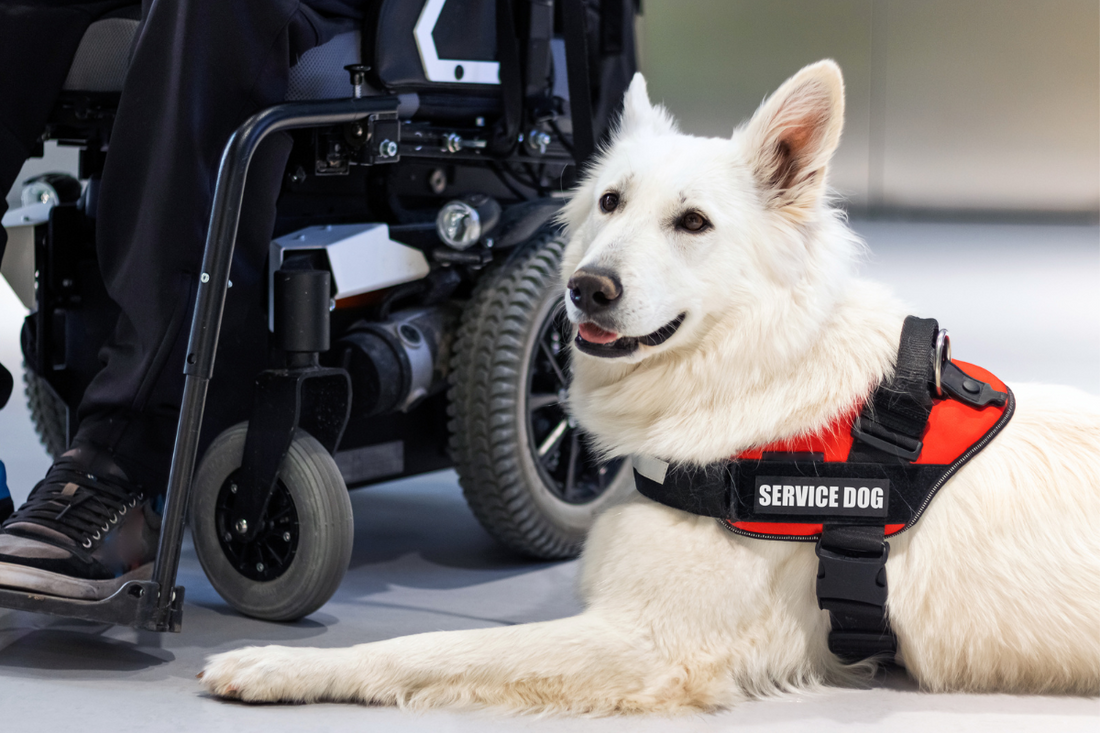The Incredible Roles of Service Dogs: How They Transform Lives

Dogs aren’t just human’s best friends! They also play an important role as service dogs.
Service dogs are amazing companions for people living with disabilities and medical conditions.
These specially trained dogs offer support, independence, and assistance by performing life-saving tasks that help their handlers stay healthy and safe. But how is a service dog different from a well-behaved family pet?
Let's dive in and find out!
What Are Service Dogs?

Service dogs aren’t just pets—they’re working animals trained to perform specific tasks that help their handlers live independently.
According to the Americans with Disabilities Act (ADA), any dog, regardless of breed or size, must be individually trained to do work or perform tasks for a person with a disability. These tasks go beyond basic obedience, making service dogs essential companions for their handlers.
How Do Dogs Become Service Dogs?
Becoming a service dog involves extensive training and dedication. It starts with selecting puppies based on their temperament and health. These puppies are placed with volunteer raisers who socialize them and teach basic obedience.

Around 12 to 18 months old, the dogs undergo evaluations to determine their suitability for service work. Successful dogs move on to advanced training, learning specific tasks like retrieving items, opening doors, alerting to medical conditions, and guiding the visually impaired. They also train to stay focused in public settings. Once trained, they are carefully matched with handlers based on their skills and the handler’s needs. Handlers then undergo training to build a strong bond and reinforce commands.
Ongoing training and regular check-ups ensure the dogs remain effective and healthy. Despite the rigorous process, these service dogs provide invaluable support and significantly improve their handlers' quality of life.
Common Service Dog Breeds
While any dog can potentially become a service dog, certain breeds are often chosen because of their temperament, intelligence, and physical traits. Common service dog breeds include:
- Labrador Retrievers
- Golden Retrievers
- German Shepherds
- Poodles
- Border Collies
- Australian Shepherds
Types of Service Dogs

Service dogs are trained to assist with a variety of mental and physical disabilities. Training can take up to two years and is highly individualized. Here are some of the incredible types of service dogs and the tasks they perform:
-
Allergy Detection Dogs These dogs can sniff out specific allergens and alert their handler, providing an early warning to prevent allergic reactions.
-
Autism Service Dogs Autism service dogs help individuals on the autism spectrum by managing sensory overload and facilitating social interactions. They can interrupt self-harming behaviors or perform calming actions when their handler is anxious.
-
Guide Dogs Guide dogs help individuals with visual impairments or blindness navigate their environment safely. They train extensively to learn how to avoid obstacles and navigate public spaces.
-
Hearing Dogs Hearing dogs alert their handlers to important sounds like doorbells, fire alarms, and approaching vehicles. They lead their handler to the source of the sound or to safety.
-
Medical Alert Dogs Medical alert dogs detect and respond to medical conditions such as diabetes and seizures. They alert their handler to changes in blood sugar levels or the onset of a seizure.
-
Mobility Assistance Dogs These dogs help individuals with mobility issues by retrieving objects, opening doors, providing balance support, and assisting with daily activities like dressing and undressing.
-
Psychiatric Service Dogs Psychiatric service dogs assist individuals with mental health conditions like PTSD, anxiety, or depression. They can recognize signs of an oncoming episode and provide grounding support.
-
Therapy Dogs While not technically service dogs, therapy dogs provide comfort in clinical settings, schools, and disaster areas. They undergo obedience training and temperament testing to interact safely with various people.
Are Emotional Support Dogs Service Dogs?
Emotional support dogs provide comfort and improve well-being, but they are not the same as service dogs. They don’t receive the specialized training needed to perform specific tasks related to a disability, and they’re not protected under the same laws as service dogs.
Service Dogs and Community

Service dogs not only provide physical support but also help their handlers connect with their community. In a 2020 survey, 94% of people with service dogs reported psychosocial benefits, including increased confidence, peace of mind, and improved social interactions. When you see a service dog in public, respect their role and avoid distractions like petting. Let them do their job to keep their handler safe.
If you have plans training your dog as a service dog we have then make sure to grab a Joyride Harness!
The Joyride Harness is perfect for service dogs and their training. Its adjustable design stops pulling without straining your dog’s throat, making walks stress-free. The easy-on, easy-off feature saves time, and the secure fit ensures comfort for all sizes. With multiple leash points and an EZ Grip handle, you gain better control during training. Reflective stitching keeps your dog safe and visible at night.
This is just a sampling of tips we offer at Joyride Harness. You can find more tips and tricks and how-tos for caring for your dog on our blog at this section. Feel free to leave a comment with tips you’re looking for!





















